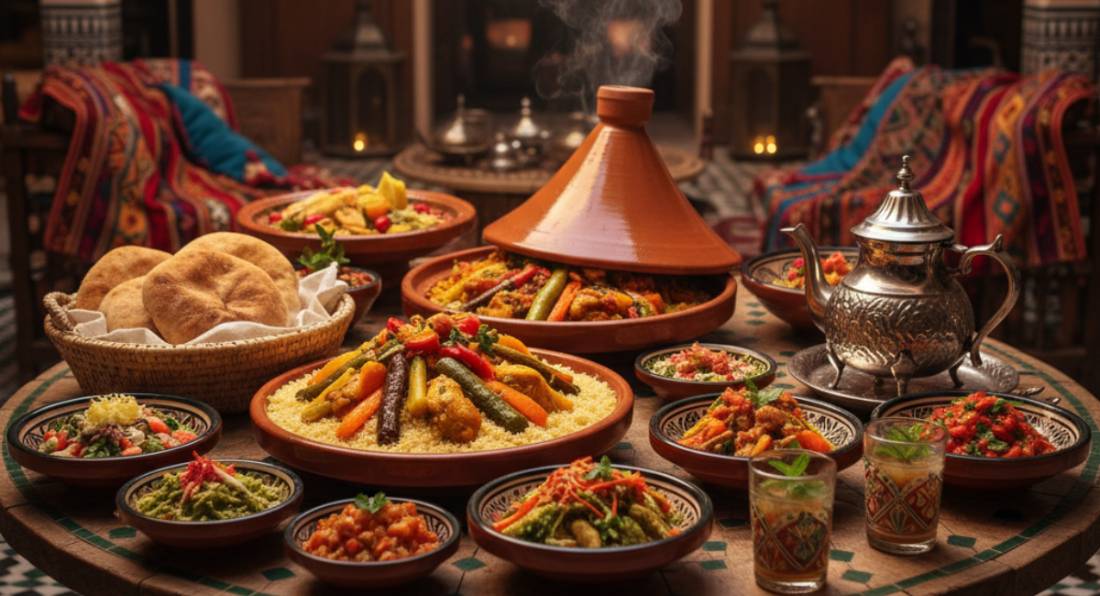Table of Contents
The Secret I Learned on the Road: Slow Down
For twenty years, my white taxi was my office. People would get in, always in a hurry, and say, “Yallah! Let’s go, let’s go!”
Everyone thinks a taxi driver needs to be fast. But I learned the opposite on those long roads between cities. To truly experience Morocco, you must slow down. That’s when you notice things, like how the dirt changes color from one region to the next, or you see the old man with his donkey sitting under a tree. You drive safer, too.
And here’s the funny thing I realized. The greatest secret to my mother’s cooking, the secret to all the best food of Morocco, is exactly the same philosophy. It’s not about a list of spices you can buy in the souk. It’s about patience. It’s about the magic of “slow cooking.”
The same respect you give the road, you must give to the fire. It’s all about taking your time.
So, instead of listing the top ten foods, I’ll give you a real tour, just as I did for my passengers. Let me show you Morocco through its food. We’ll make a few stops along the way. First, we’ll start in the old Imperial Cities where history simmers in every pot. Next, we’ll climb the winding roads of the Atlas Mountains to taste the simple food of the Berber people. Then, following the scent of salt and grilled fish along the Atlantic Coast, we’ll eventually venture deep into the Sahara, where the sun and wind are the main ingredients.
This is the real tour. Come on, let’s take a drive through the real food of Morocco
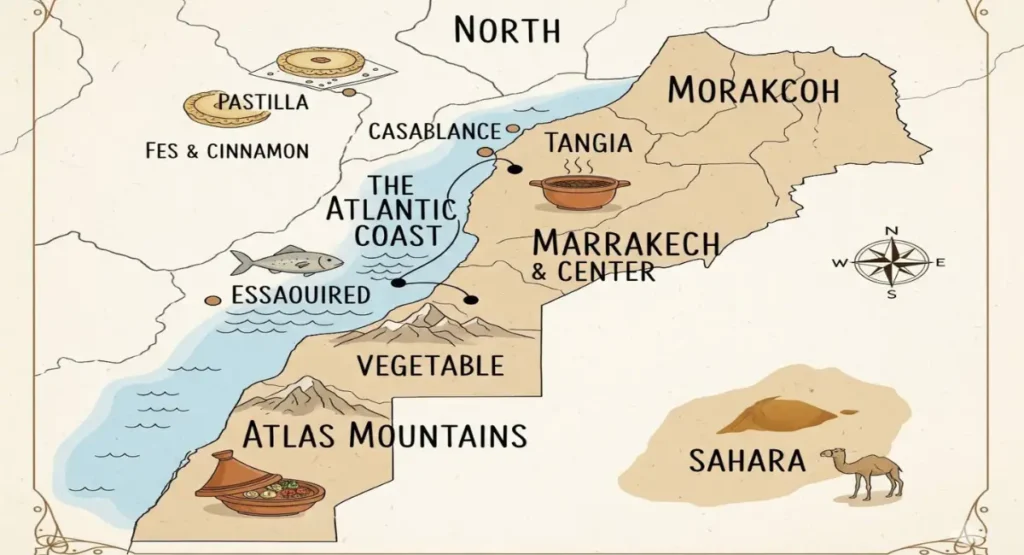
The North & Imperial Cities: A Taste of History & Sophistication
I always knew when I was getting close to the North. You leave the flat plains, and the road starts to climb. The air just feels different. Older.
The food up there, in cities like Fes, Meknes, and Tangier, it’s the same way. This isn’t fast food. It’s the old-style cooking from the palace kitchens. Recipes that families have kept secret for a very long time.
You feel that history when you eat it. You get hints of old Andalusia, from Spain, with almonds and sweet spices mixed with savory meat. The dishes here are layered, complicated, and they take time. This is where you really start to understand my philosophy of slow cooking.

Pastilla – The Sweet & Savory Pie of Fes
Pastilla… now that’s a special dish. If you ask someone from Fes about it, you’ll see them stand up a little straighter. It’s their pride. You don’t eat this on a normal day. It’s for big celebrations, like a wedding, when you really want to impress a guest.
The work is incredible. You have many layers of super-thin pastry. Inside, it’s filled with slow-cooked chicken, spices like saffron and cinnamon, and almonds. After it’s baked, they put powdered sugar on top. The first bite confuses people. Is it sweet? Is it savory? It’s both.
It’s a magnificent, complicated thing, and it really holds the soul of Fes’s grand history. The full recipe has a few secrets to make it easier, which I’ll share with you.
Rfissa – A Generous Dish for Celebrations
I remember a trip I made once, picking up a whole family from the airport. They were so excited. Their first grandchild was just born. So I asked, “What’s the first big meal you’ll have to celebrate?”
The grandfather, the son, everyone… they all shouted at once: “Rfissa!”
This dish is about celebration, about generosity. It’s chicken and lentils, cooked down for a long time in a beautiful broth. The flavor comes from Ras el Hanout and a funny little seed called fenreek, which gives it a very unique, comforting smell. You pour all of this over a bed of shredded Msemen bread.
It’s the kind of warm, soulful meal that says “welcome home.”
B’ssara – The Humble & Hearty Soup of Tangier
But don’t think the North is all about fancy pies. They also make simple food that’s just as good.
When I go to Tangier or Tetouan in the early morning, I see workers and fishermen eating hot bowls of B’ssara from little street stalls. It’s just a thick soup made from fava beans, cooked for hours with garlic, cumin, and a swirl of olive oil on top.
It costs next to nothing, but one bowl makes you feel strong for the whole day. People eat it for breakfast. Sometimes the most humble food is the most powerful.
The Atlantic Coast: Freshness Forged by Ocean Winds
Every time I drove a passenger to the coast, maybe to Essaouira, I knew we were getting close without even seeing the ocean. You just open the window, and you can smell it: salt and grilled fish.
The whole rhythm of life is different there. It’s dictated by the tides, by what the little blue boats bring back to shore each morning. The food follows that rhythm. The star of the menu isn’t decided by the butcher; it’s decided by the ocean.
I remember talking to an old fisherman on the port in Safi. He was mending his nets, and I was drinking a coffee. I was telling him about my philosophy of slow cooking. He laughed, a big, hearty laugh. He pointed to his boat and said:
“Khalid, your tagines from the land need time, because your animals are tough. My fish… it was swimming this morning. It doesn’t need time. It needs respect. Cook it fast, or you will ruin it.”
That’s the one place in Morocco where my rule changes. On the coast, freshness is the secret, and speed is the technique.
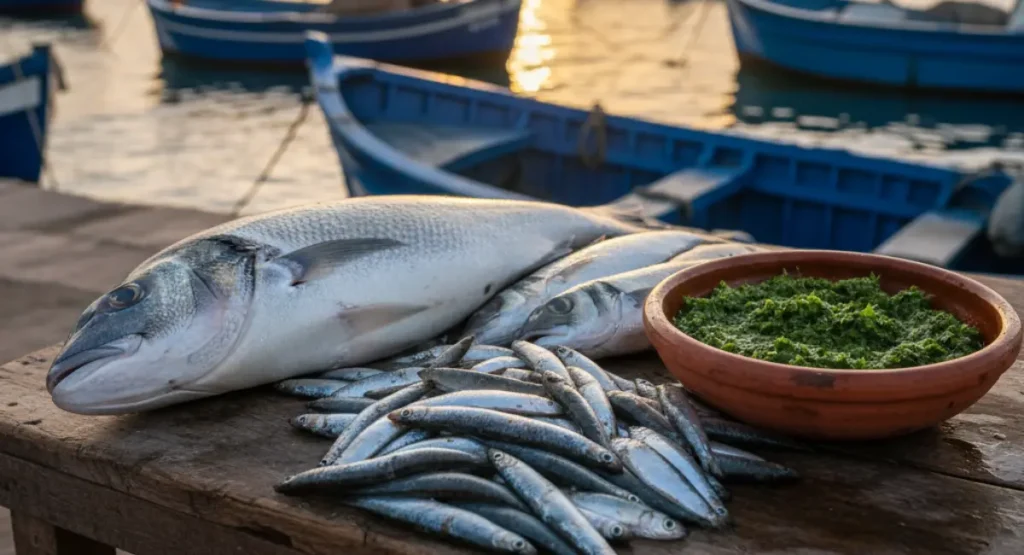
Fish Tagine with Chermoula – The Taste of the Ocean
So, they make tagines on the coast, of course, but it’s a different animal. It’s a fast tagine, a tagine that tastes bright and zesty, not deep and slow-cooked.
The magic of this dish doesn’t come from the pot. It comes from the marinade they use for all their fish. It’s called chermoula. This stuff is the green soul of our coastal food. It’s a simple blend of fresh cilantro and parsley, a lot of garlic, cumin, paprika, all brought together with olive oil and the juice of a good lemon.
They take the fresh fish of the day, cover it in this green paste, and lay it over a bed of potatoes and carrots in the tagine. You only cook it until the fish is white and flaky. It’s a light dish, and it really tastes like the sea.
Stuffed Sardines – A Simple Coastal Delicacy
Now, I know what people think when they hear “sardines.” You have to forget the little tin cans. The sardines on the coast are fresh, big, and really good.
The best way to have them is stuffed. It’s a street food you see everywhere there. They just put a layer of that chermoula between two sardine fillets, press them together, dip them in flour, and fry them.
You eat them hot, with your hands, right there by the water, maybe with a little bowl of olives and some spicy harissa on the side. It’s a simple thing, doesn’t cost much, but the taste is incredible.
Marrakech & the Heart of Morocco: A Crossroads of Spice & Soul
I always told my passengers, “You don’t just visit Marrakech, you feel it.” As you drive closer, the very earth turns red. The sun seems to hang hotter in the sky.
It’s a city that moves fast. For a long time, it was the center of trade, where people from the desert met people from the north. The food is like that, too. It’s bold and full of spice.
If you walk through the main square, Jemaa el-Fnaa, at night, you’ll see what I mean. The whole place is filled with smoke from all the food stalls. It’s a bit chaotic, but in a good way. The food here has a strong personality, just like the city.
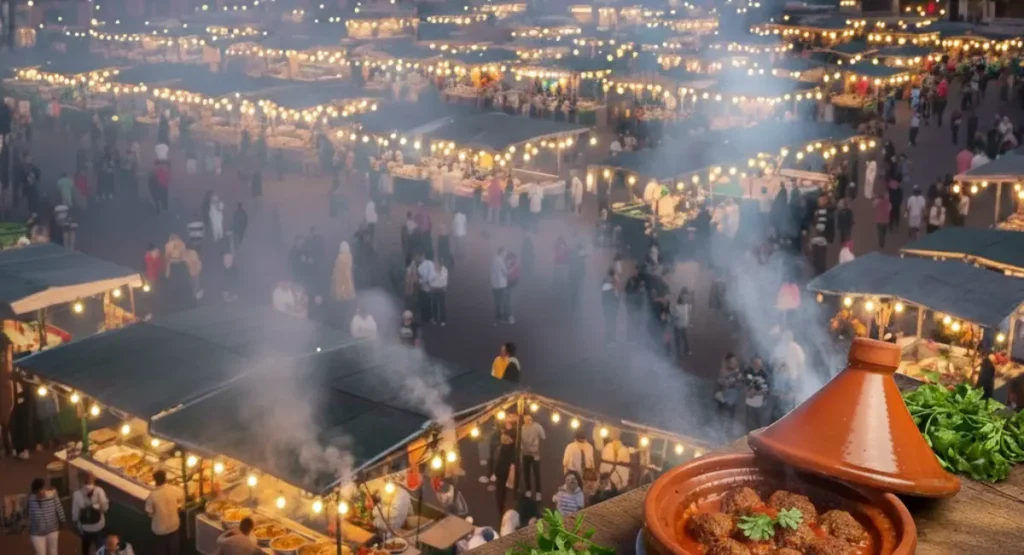
Tangia – The Ultimate Expression of Slow Cooking
If you want one dish that explains Marrakech, it’s the Tangia. This isn’t a family dish from a mother’s kitchen. This is the food of the city’s working men.
I used to see the artisans in the souk, the shopkeepers, preparing it in the morning. They take a special clay jar, the tangia, and stuff it with meat, a whole head of garlic, a preserved lemon, and a huge amount of cumin. Then they put a paper lid on it and tie it shut.
And here’s the magic part: they take it to the local hammam, the public bath. The man who runs the furnace for the hot water buries the pot in the hot ashes, and it just stays there. For hours. Sometimes all day long.
This is my “slow cooking” philosophy at its most extreme. When that meat comes out, you don’t need a knife. You don’t even need a fork. It just falls apart. The flavor is very deep and rich.
Kefta Mkaouara – The Comforting Meatball Tagine
You know how every city has its own simple, everyday dish? In Marrakech, for me, that’s the Kefta tagine. You find it in all the small restaurants.
It’s just little meatballs seasoned with paprika and cumin, cooked in a tomato and onion sauce. At the end, they crack an egg on top and let it cook right there. You use your bread to break the yolk and scoop everything up. It’s a simple, perfect meal.
Couscous – The Dish That Gathers Families on Friday
Of course, you find couscous everywhere in Morocco. It’s our national dish. But it always felt a little more special in Marrakech, maybe because the city is the heart of the country.
Friday is our holy day. And after the prayer, the whole country stops to eat couscous. It’s a dish that’s all about family, about sharing from one big plate. They steam the fine grains of semolina over a big pot of broth until they’re as light as air.
Then they pile it high on a platter, with a mountain of tender vegetables and meat on top. Sometimes, they add a sweet topping of caramelized onions and raisins called Tfaya. Sitting down for couscous on a Friday… It’s more than just lunch. It’s a ritual. It’s what makes us Moroccan.
The Atlas Mountains: Simple Food from a Noble Land
Every time I left Marrakech and pointed the taxi towards the mountains, I had to change the way I drove. You couldn’t be in a hurry up there. The road gets narrow, with the cliff on one side and rocks on the other. It forces you to slow down.
But it’s funny, the slower you have to go, the more you really see. You’ll spot a goat on a tiny ledge and think, “How did he even get up there?” You see the little villages, you know? They look like they grew right out of the ground.
That’s Berber country up there. The original people. Their food is a lot like them, I think. Strong, simple, no-nonsense. You don’t find fancy palace cooking in the mountains. You find food that comes from the earth.
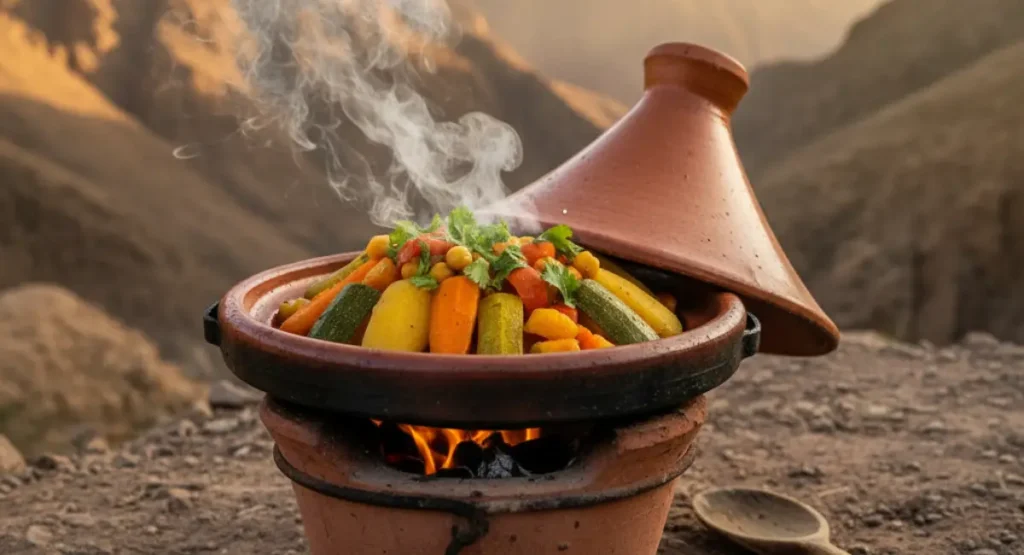
Berber Vegetable Tagine – A Celebration of the Land
I remember a flat tire I got, way up high. I’m struggling with it, and this old man comes out of his house. He just shakes his head and waves me over.
‘Forget the tire,’ he tells me. ‘Come eat. The boy will fix it.’
So we just sat on a carpet on the ground while his son worked on my taxi, and his wife brought out a vegetable tagine. Let me tell you, I thought I knew what a carrot was supposed to taste like. I was wrong.
I kept trying to figure out the secret spice, but the old man just laughed. There was no secret spice. It was just the vegetables, pulled from the garden that morning and cooked for a long, long time over a small charcoal fire called a majmar. Everything tasted more like itself. It tasted like the good dirt it came from. Real food.
Everything tasted more like itself. The potato was the most potato-y potato I’ve ever had. Sometimes, they finish it with a little drizzle of nutty argan oil, which they make right there. You really felt like you were eating a piece of the mountain. It’s honest food.
Méchoui – The Slow-Roasted Lamb of Great Festivities
Now, the Méchoui… that’s a different story. You only see that when there’s a big party, a wedding, or something. It’s not a meal you make for two or three people.
The men dig a big hole in the ground. They get a whole lamb, not a lot of fuss with spices, and they lower it right in there. They cover it and let it cook for hours and hours.
When it’s ready, they pull it out, and the whole village comes. Everyone just gathers around and pulls off pieces of the meat with their hands, using fresh Khobz to catch all the juice. Nobody is quiet. There’s a lot of laughing. It’s not just about eating. It’s about everyone being together.
The Deep South & Sahara: Flavors Forged by Sun and Wind
After you cross the Atlas Mountains, it’s like you’re driving into a whole other country. The road just goes straight, forever. The first few times I drove it, I kept thinking something was wrong with my radio because it was so quiet. Then I realized, no, that’s just the sound of the desert. Just the hum of the engine and the heat. You can go for an hour and not see a single other car. It’s a place that makes you feel very small.
I’ve taken all sorts of people down this road. I’ve driven young surfers with sun-bleached hair, their boards strapped to the roof, heading all the way down to Dakhla, where the wind and the ocean are in a constant, powerful conversation. I’ve also driven adventurers, the quiet types with worn-out backpacks, who wanted to be dropped off at the edge of the great sand dunes of the Sahara. They were all looking for something big, something real.
And the food down there is made for people like that. It’s not fancy. It’s fuel. It’s the kind of food that has to be cooked for hours because the ingredients themselves are tough, shaped by a hard land. It’s food that gives you the strength to keep going.

Camel Tagine – A True Taste of the Desert
I’ll never forget a passenger I had, an Australian man who had read every book about the desert. He got in my taxi in Marrakech and said, “Khalid, I don’t want the tourist food. I want to taste the Sahara.” For him, that meant one thing: camel tagine.
You won’t find that on the menu in Jemaa el-Fnaa. We had to drive for hours, deep into the south, to a small town where the weekly market was full of nomads. That’s where you find the real thing.
The meat from a camel is incredibly lean and dark red. It has very little fat, which means it can be tough as shoe leather if you cook it fast. It is the ultimate test of my slow-cooking philosophy. The old man who cooked it for us didn’t rush. He seared the meat first, then added a powerful blend of spices – much more cumin and ginger than you’d use up north – and let it simmer in the tagine for what must have been half a day. He barely looked at it. He just knew.
He lifted the lid, and the smell that came out… it was strong, like the desert after it rains. The meat was so tender you could just push it with a piece of bread and it would fall apart. It was powerful stuff. The Australian man ate with his eyes closed. “Now I’m here,” he said.
Medfouna – The Legendary “Berber Pizza”
If the camel tagine is the taste of the desert, the Medfouna is its ingenuity. Everyone calls it ‘Berber pizza’ to explain it to tourists, but it’s not a pizza. A pizza is fast food. This is the opposite. This is slow food. It’s a whole, hearty meal hidden away. I’ve shared it with families who pack it for long journeys. It’s the original portable meal.
The women prepare the filling. It’s usually ground meat, a lot of onions, some herbs, and their own mix of spices. Sometimes they’ll put some almonds in there, or a hard-boiled egg. Then they wrap it all up in a simple bread dough, sealing the edges so none of the good stuff can escape.
But the real genius is the cooking. They don’t use an oven. They go outside, dig a shallow pit in the clean, hot sand, and place the Medfouna directly in it. They bury it and build a small fire right on top. The sand cooks it from all sides, slow and even. And when they dig it up and you cut it open, all the steam rushes out. It smells incredible. It’s honest-to-God food for a long journey.
Dishes Found Everywhere: The Daily Soul of Moroccan Food
After driving through all the different regions, you start to see something interesting. You see that while every place has its special dish, some foods are like the main road that connects all the villages. They are everywhere.
My mother didn’t need a special occasion for these dishes. This was the food for a normal Tuesday, the kind of meal that makes a simple day feel good. This is the daily soul of our kitchen.
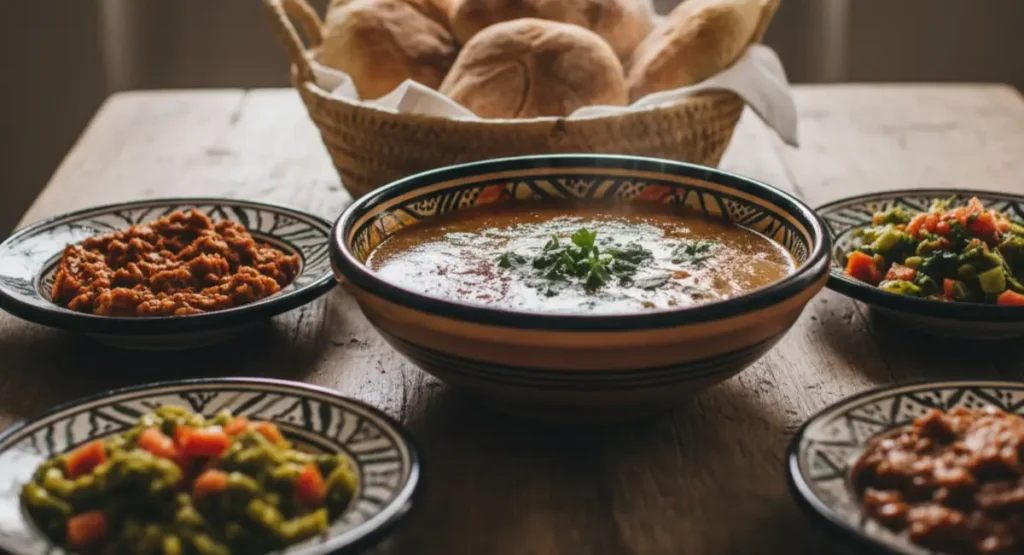
Zaalouk & Taktouka – The Essential Cooked Salads
Before the tagine even arrives, the little plates come out. And on those plates, you will always find these two. They are the welcoming committee of any real Moroccan meal.
Zaalouk is all about smoky eggplant cooked down with tomatoes until it’s soft and rich. Taktouka is its cousin, made with sweet bell peppers instead. My mother used to let them simmer on the fire forever, until you could barely tell where one vegetable ended and the other began. You don’t eat them with a fork. The only tool you need is a good piece of bread to scoop them up.
Harira – The Soup That Warms the Nation
During Ramadan, the whole country waits for that smell. It means the fast is over for the day. I think every family in Morocco believes their recipe is the best one.
After a long day with no food or water, that first warm spoonful of Harira feels like it brings you back to life. A bowl of it, a few dates… It’s a taste of comfort that unites the whole country every single night for a month.
Khobz (bread) – The Daily Bread That Unites Everyone
“A table without bread is not a real Moroccan table.”
My father always said that. He was right. You can still see it today. In the mornings, the whole neighborhood smells of fresh baking because everyone takes their dough to the local oven, the ferran.
Khobz is our fork and our spoon. It’s what we use to soak up the sauce from a tagine, to scoop up the salads, to make a sandwich. It’s on the table of the king and on the table of the working man. More than any other food, this daily bread is what truly unites everyone.
A Final Stop at the Table: Mint Tea & The Art of Hospitality
In my taxi, the journey wasn’t finished until I brought my passenger safely to their hotel door and said, “Bessaha, welcome.” It’s the same thing with a Moroccan meal.
The tagine can be empty, the bread all gone, but the meal is not over. Not yet. There is always one final act, a ritual that says, “You are welcome in this house, please, stay a little longer.” It’s the moment where everyone leans back, and the conversation gets softer. It’s the moment for tea.

Moroccan Mint Tea – More Than a Drink, It’s a Ceremony
You can travel all over Morocco, from a rich house in Rabat to a simple tent in the desert, and the first thing people will offer you is a glass of tea. It’s our way of saying hello, of making a friend, of closing a business deal. But it’s never just a teabag in a cup. To refuse a glass of tea is almost an insult; to prepare it for a guest is a true sign of respect.
Making the tea is a real performance, and it’s usually the man of the house who does it. I can still see my father with his silver teapot, the berrad, and his tray of colorful glasses. He’d start by pouring a little hot water over the green tea in the pot, swirl it around, and pour it out. “That’s to wash the dust off,” he’d say. “It gets rid of the bitterness.”
Then comes the magic. He stuffs the pot with a huge handful of fresh, fragrant mint leaves – it has to be a lot – and adds a big chunk of sugar from a sugar cone. You cannot have just a little sugar. Then comes the most important part: the pouring. He will lift the teapot high, high up in the air and pour a thin, perfect stream of tea into the first glass, then pour it back into the pot. He does this two or three times. This is not for show. This mixes the tea and cools it down just enough.
Finally, he pours it for everyone, always from high up, to create a little layer of foam on top of each glass. We call that foam the “turban” (rezza). My father wouldn’t even serve a glass if it didn’t have a good turban on it. He’d say, “This one is naked!” and pour it again. It was his way of showing you that he took the time, that you were important.
Moroccan Pastries – A Sweet Finish
And what goes perfectly with a hot, sweet glass of mint tea? A little something sweet to eat. A proper host will always bring out a plate of pastries.
I swear, you can make a hundred different kinds of cookies, but most of them get their soul from three things: almonds, honey, and that beautiful smell of orange blossom water.
The most famous one is shaped like a little crescent, the one we call Kaab el Ghazal. You know, “gazelle horns.” The outside is a thin pastry that’s almost see-through, and when you bite into it, you get this soft, chewy filling of ground almonds. It’s not too sweet, just perfect. It’s that little sweet bite at the end that makes you feel like the meal is truly, finally, complete.
A Few Things People Always Ask Me
What is the most famous dish in the food of Morocco?
The two most famous dishes are undoubtedly the Tagine, a slow-cooked stew named after the clay pot it’s cooked in, and Couscous, which is traditionally served with vegetables and meat every Friday. They are the true heart of our cuisine.
What is the main secret to authentic Moroccan cooking?
The biggest secret isn’t a specific spice, but a philosophy: “slow cooking.” As a taxi driver, I learned that you must respect the road and take your time. It’s the same in the kitchen. Patience and slow, low heat are what allow the simple ingredients to develop incredibly deep flavors.
Are there good vegetarian options in Moroccan food?
Yes, absolutely! Moroccan cuisine is very rich in vegetarian dishes. The Berber Vegetable Tagine is a perfect example, celebrating the fresh produce of the land. Our famous cooked salads like Zaalouk (eggplant) and Taktouka (bell pepper), and hearty soups like B’ssara (fava bean) are all naturally vegetarian and delicious.
What is the most important spice in a Moroccan kitchen?
While we use many spices, a famous blend called Ras el Hanout is very important. It can contain over 20 different spices and every family has its own secret recipe. However, the “holy trinity” of spices you’ll find in almost every savory dish is cumin, ginger, and turmeric.
Is mint tea really that important in Morocco?
It is more than important; it’s a symbol of our hospitality. We call it “Moroccan whiskey.” It’s offered to guests in every home, used to celebrate friendships, and to close business deals. The ceremony of preparing and pouring the tea is a true sign of respect and welcome.
My Final Thought: From My Taxi to Your Kitchen
After so many years behind the wheel, you learn a thing or two. And the main thing isn’t about speed. It’s about what you see when you finally slow down.
It’s funny because the kitchen taught me the very same thing. You can’t bully a tagine into cooking faster. It takes the time it takes. You have to respect that.
So when people ask me for the one big secret to our food, they always think it’s a special spice blend you can only get in a hidden shop in Fes. But the truth, the real secret my mother knew, is simpler. It’s just time. It’s giving the food the time it needs to become something wonderful.
But these are just my stories, my memories. The best part of this whole thing is when you take them into your own kitchen. I hope you’ll try one of these recipes. When your home starts to smell of our spices, cumin and cinnamon… Well, that smell says more than I ever could.
You’ll be making your own story, your own memory with these flavors. You’ll be bringing a little piece of my Morocco right to your table. And that, my friend, is the best recipe there is.
Bessaha!
Ready for Your Next Culinary Journey?
This guide was the map of our journey together, showing you the different roads and the special foods at the end of each one. But the real destination is your kitchen.
Every dish we talked about on our drive—from the sweet & savory Pastilla of Fes to the simple Berber Tagine of the mountains—has its own detailed recipe waiting for you. These are my family’s methods, the ones I learned over years, written down so you can bring them to life.
All you have to do is choose your first stop.
From My Kitchen to Your Inbox
This is just one of the many stories and recipes I’ve collected over the years on the road. The journey doesn’t have to end here. If you’d like, I can send my next destination—and the authentic recipes I find there—straight from my kitchen to your inbox.
📩 Join Our Moroccan Foodie Community
Get the best Moroccan tagine recipes and seasonal culinary tips straight to your inbox.
Share This Culinary Journey
Your Turn: Let’s Continue the Conversation
I’ve shared my stories from the road and from my mother’s kitchen. Now, the space below is our table. This is where the conversation continues.
I would love to hear your stories. Did one of these dishes bring back a memory for you? Do you have a family recipe with its own secret? Which stop on our culinary journey will be your first?
I look forward to reading your thoughts and answering any questions you might have.
